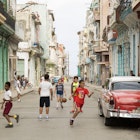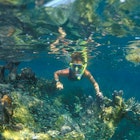

Fusterlandia's colorful tiles spread across an entire neighborhood @ Bailey Freeman / Lonely Planet
It’s time to hail Havana as one of the world’s great art cities. The Cuban capital has never lacked artistic credentials, but a growing band of small private galleries, fresh interest in outlandish street art and the emergence of the extraordinary art collectives has sparked a creative renaissance that has truly put the city on the map.

Artistic roots
Havana’s artistic roots go deep. The city is home to the oldest arts academy in Latin America, the Academia de Bellas Artes San Alejandro, housed in a colonnaded building in Marianao. Founded in 1818, the academy has bred generations of precocious talent, most notably in the 1920s when it spawned the Vanguardia, a loose collection of painters and sculptors who, rejecting the contemporary penchant for mundane landscapes, invented Cuba’s avant-garde.
- placement: fullWidth
- path: articles/in-content-top
- possible size: [970, 250], [970, 90], [728, 90], [300, 250], [320, 50], [1, 1],
- targeting:
{ "url": "havana-a-great-art-city-on-the-rise" }
Where to start
For an introductory exposé to the heady world of Cuban art, proceed directly to the bedrock of Havana’s art scene, the Museo Nacional de Bellas Artes, a huge multifarious art museum spread over two campuses in Centro Habana. The ‘Arte Cubano’ section is the finest collection of Cuban painting in the world. Artists to look out for include Victor Manuel Valdés, executor of the haunting Gitana Tropical, a painting sometimes referred to as the ‘Latin Mona Lisa’ that today is seemingly reproduced on every shower curtain and umbrella in Cuba. Another star is Wilfredo Lam, a colleague of Picasso who absorbed his Spanish amigo’s envelope-pushing spirit, but also nurtured distinctive Cuban themes such as Santería. Lam dominates the middle section of the museum with his dark, abstract works, including his most graphic, Tercer Mundo.

Havana's gallery scene
Havana has a rich seam of smaller galleries scattered around town displaying art that hasn’t yet earned its place in the Museo Nacional de Bellas Artes. The finest temporary exhibitions are held in the Centro de Arte Contemporáneo Wilfredo Lam, a diminutive gallery cum cultural center with a popular cafe that curates revolving contemporary shows and hosts the Bienal de la Habana, the city’s main art festival (held, somewhat bizarrely, every three years). For something even more bizarre, head up the road to Ojo del Ciclón, the artistic lair of Leo D’Lázaro where you can peruse clever interactive exhibits made out of bashed-up old cars and second-hand suitcases. It’s an apt mode of expression in a country where shortages still bite.
D’Lázaro’s studio isn't the only of its kind. Habana Vieja is awash with intriguing workshops where it’s possible to converse with brush-wielding local artists and buy signed copies of their work. The Taller Experimental de Gráfica is an engraving workshop where you can meet, join (there are courses) and purchase from top graphic artists.
Art Factory
If the Museum Nacional de Bellas Artes is one bookend to Havana’s art scene, the Fábrica de Arte Cubano is the other. The brainchild of respected Cuban fusion musician, X Alfonso, this multi-faceted art emporium in Vedado is less about the past and more about the future. Housed in an old olive oil factory, the Fábrica’s philosophy is to make art of all types (including music and dance) more accessible to the masses. Entrance fees are thus kept low (CUC$2) and interaction with artists is actively encouraged. A good night at the Fábrica might deliver cutting-edge t-shirt screen-printing, a male-voice choir, a jazz jam, a DJ lesson and tango dancing lessons.
- placement: fullWidth
- path: articles/in-content-middle
- possible size: [970, 250], [970, 90], [728, 90], [300, 250], [320, 50], [1, 1],
- targeting:
{ "url": "havana-a-great-art-city-on-the-rise" }

If the Fábrica is too crowded or pretentious for your liking, head over to Enguayabera, a similarly styled art collective that recently opened well off the tourist grid in Havana’s Alamar district.
Art cafes & restaurants
In a city where international cafe and restaurant franchises are still absent, it’s not uncommon to find yourself imbibing coffee in a makeshift gallery discussing Che Guevara’s contribution to Cuban poster art with a bohemian barista. A number of Havana’s cafes (opened since the relaxation of business laws in 2011) have a strong artistic bent. Looking like a bookish nook from Paris’ Left Bank, El Dandy in Habana Vieja is a fount of good coffee and even better photo art. In a street nearby, Espacios Old Fashioned displays huge abstract canvases etched with stark primary colors that get brighter the more mojitos you sink. Across the city in Vedado, Café Bar Madrigal, a two-storied mansion that features posters and images of iconic Cuban films like Lucía, Madrigal and Sweet Havana.

Churches
Considered anti-revolutionary during the Fidel Castro years, religious worship has re-emerged in Cuba following visits by three different popes. As a result, renovated churches have dusted off their faded canvases and made some important rediscoveries. First port of call for art historians should be Havana Cathedral where care and attention has been given to some early 19th-century frescos by Italian artist Giuseppe Perovanni. More revolutionary but less heralded is the interior of the Iglesia de Santa María del Rosario in the eponymous Outer Havana neighborhood, where you can view the religious musings of one of Cuba’s earliest artists, José Nicolás de la Escalera, the first person to depict black slaves in his paintings.
Street art
Street art is Havana’s sizzling undercurrent. Visible manifestations of street art have been around since the 1950s. Check out the huge mural, Frutas Cubanas, by Vanguardista Amelia Peláez on the façade of the Hotel Habana Libre. After the revolution, the government filled the city with propaganda-spouting billboards, some of which have artistic merit. The iconography was taken up by Cuban pop artist Raúl Martínez in the 1960s and reached its zenith in the massive steel stencil of Che Guevara by Cuban artist Enrique Ávila González that dominates the Plaza de la Revolución.
- placement: native
- path: articles/in-content-native
- possible size: [f, l],
- targeting:
{ "url": "havana-a-great-art-city-on-the-rise" }

By the 1990s, street artists were experimenting in other genres. The Callejón de Hamel is an inspired art project set in a narrow back alley in Centro Havana. The adornments, including ultra-colorful murals, sculptures fashioned out of scrap metal, and objects relating to Santería, were spearheaded by surrealist artist Salvador González, who maintains a studio on the street.
Havana’s best alfresco art isn’t confined to a mere street – it covers an entire neighborhood. Fusterlandia in the fishing community of Jaimanitas is the crazy conception of José Fuster, a proponent of a folkloric artistic style sometimes known as ‘naïve art’, and an unashamed disciple of Catalan architect Antoni Gaudí.

Fusterlandia began in the 1990s, but it’s only more recently that it has started to gain international attention and become firmly entrenched on Havana’s tour circuit. To date, Fuster has covered over 80 houses with mosaics, murals and curvaceous parapets heavy with Cuban themes and influences. The overall impression is at once surreal and dream-like, but also wonderfully upbeat, sunny and playful. No photo can do it justice.
The city's love for street continues and has found its way into the center of San Isidro. The once-industrial neighborhood located next to Avenida del Puerto in Habana Vieja is now home to striking urban art etched on decaying facades and houses within five or so walkable blocks.
Aiming to revitalize this less-touristy area, international graffiti artists such as @Abstrk and Stephen Palladino have joined Cuban creators in an open-air gallery filled with vivid colors, geometric designs and thought-provoking portraits.
First published in 2017. Lonely Planet Local Diana Rita Cabrera contributed to the update of this story.
- placement: fullWidth
- path: articles/bottom
- possible size: [970, 250], [970, 90], [728, 90], [300, 250], [320, 50], [1, 1],
- targeting:
{ "url": "havana-a-great-art-city-on-the-rise" }
Explore related stories








 National ParksThe best spots for snorkeling in Key Largo, from wrecks to reefs
National ParksThe best spots for snorkeling in Key Largo, from wrecks to reefsJun 3, 2022 • 5 min read
 Art and CultureThe 8 best museums in Havana for art, history and cultural icons
Art and CultureThe 8 best museums in Havana for art, history and cultural iconsMar 12, 2022 • 7 min read

